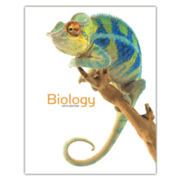BJU Press Biology is a course that is suitable for homeschoolers although it is best for use in a group class that meets at least once a week for discussion and lab work. The homeschool subject kit includes a student textbook, a two-volume teacher’s edition, a student lab manual, a teacher's edition of the lab manual, tests, and an answer key for the tests.
The arrangement of topics in the textbook is fairly traditional, beginning at the cellular level and working up to human beings. Botany receives less attention than in some other high school biology courses, while cytology (cells) and microbiology are given greater coverage. A biblical Christian worldview is evident throughout the text, and significant attention is given to the creation/evolution controversy. Chapter 10, "When Worldviews Collide," is entirely devoted to evolution and creation. Evolutionary theory and its application are discussed so that students will be familiar with the information they are expected to know for standardized tests. That information is countered with explanations from a young-earth, creationist viewpoint.
The textbook has loads of full-color images, and the text is written in an engaging fashion with plenty of real-life applications. (This is an improvement from earlier editions.) As one would expect, there are many bolded vocabulary words that students are to learn. The textbook has some information and activities that you can use at your discretion under the headings "Case Studies" and "Worldview Sleuthing." These look very interesting.
You should read the introductory information in the teacher's edition for the textbook (TE) for useful advice on teaching the course. However, be aware that the TE is written for teachers working with a class group, so some of the information is not pertinent when students are doing most of their work independently.
In the TE, slightly reduced images of student pages are surrounded by teaching information and answers for questions. The teaching information is not laid out step by step. It's just there for you to use or not. A lesson plan overview at the front of each volume of the TE has lesson plans showing objectives, which pages to read, when to do labs, and when to take tests. While it doesn't specify when to use most of the supplemental teaching information, it shouldn't be difficult for a teacher preparing a lesson to figure that out. Students reading the text on their own will probably miss out on that information. It's not critical to the course, but it is important for you to know that there is some interesting content that shows up only in the TE.
There is more content in the textbook than most students can cover, so it would help if a parent or teacher were to create lesson plans showing students specifically what they want them to cover. The CD that is included at the back of the TE has a full-year lesson plan, an image gallery, and instructions for using this same Biology textbook to teach an additional full-year course on anatomy and physiology—which assumes that when you first teach the course you skip the six chapters on those topics that comprise the final unit.
Each chapter is divided into subsections, and review questions follow each subsection. At the end of each chapter, there are a list of key terms, a set of review questions that cover the entire chapter, some true-or-false questions, and critical thinking questions. Occasionally, some of the review questions (both subsection and chapter) are marked with a blue box indicating that they require problem-solving or deeper thought, and others are marked with an orange box to show that they will require some research.
The Lab Manual is a separate book with its own teacher's edition. It is possible to use the text without a lab, although lab work makes the content more interesting and complete. It also fulfills the lab requirement most students need to meet for either graduation or college entry. The lab work is classroom oriented, but the teacher's edition for the lab manual does suggest alternatives for some equipment and experiments since some Christian schools have limited lab equipment. The authors have tried to select lab activities and equipment for which students and schools get the most value for the cost involved. For example, they require a microscope since it is used so frequently and is an essential tool for lab work. However, they try to avoid expensive equipment that gets minimal use. It might be most practical to purchase the lab kit designed for this course by Logos Science, since it was designed with both small schools and homeschoolers in mind.
BJU Press' Biology should serve well for those looking for an academically challenging, worldview-based biology course that includes a lab component.













